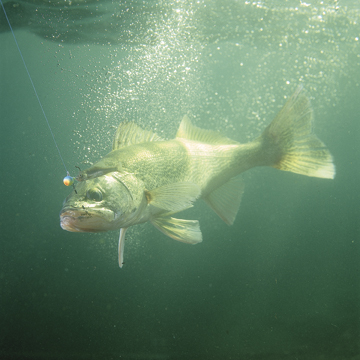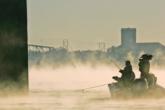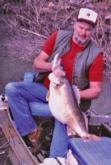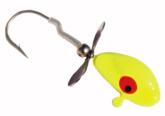Ice-out
Spring can produce some astonishingly big walleyes

Fishing for walleye early in the spring offers two undeniable benefits – the fish can be fairly easy to find, at least compared to other times of the year, and the fish can be the biggest you’ll catch all year. Do you need any other reasons to fish in the spring just as soon as the weather will let you?
Walleye fishing can sometimes be a tough proposition at other times of the year. But after ice-out, the biggest fish with the most advanced metabolisms begin to stir first, and that means big hens that have been forming up their eggs over the winter. “Prespawn fish can be the easiest of the year. Basically, that’s because the bigger females are starting to stage, starting to go into their spawn patterns. That cuts down the area where you’re looking for them to rather defined areas,” said FLW Walleye Tour pro Rick LaCourse of Port Clinton, Ohio.
Before turning pro, the Ranger pro was a walleye guide on massive Lake Erie for more than 25 years. His biggest ‘eye to date is a 14.3-pounder. “We might have 50 million walleyes in Lake Erie,” he said, “but 90 percent of them spawn in the Western Basin. They’ll start to stage in the late fall and through the winter. And they’ll be doing that close to their spawning areas. That’s anyplace where they’ve got hard bottom, like rock or gravel. On Lake Erie, that means reefs and good gravel shorelines. They’ll spawn in 10 to 12 feet of water, so when you’re looking for spring prespawn fish, fish deeper water off those spawning areas.”
Deeper water in the spring usually means looking for fish in 15 to 35 feet of water. “Those fish are roaming,” LaCourse said. “They’re feeding when they can, but they’re not feeding as much as they do in warmer water.”
 So, you’re concentrating your search out and away from, but in proximity to, places where the walleyes will eventually spawn. Deep water close to a gravelly shoreline, for example, or deep water adjoining a hard-bottom reef or island with a gravel shoreline, are all good places to start looking in lakes and reservoirs. In rivers, it can mean fishing deeper water adjoining shallow, littoral spawning areas.
So, you’re concentrating your search out and away from, but in proximity to, places where the walleyes will eventually spawn. Deep water close to a gravelly shoreline, for example, or deep water adjoining a hard-bottom reef or island with a gravel shoreline, are all good places to start looking in lakes and reservoirs. In rivers, it can mean fishing deeper water adjoining shallow, littoral spawning areas.
Prespawn and spawn periods vary according to how far north (or south) you are. In northern waters, walleyes need warming water temperatures to mature their eggs. Water in the mid-40 degree range is about when they start the spawn proper, so prespawn is taking place in that period when the water is less than that ideal spawning temperature.
Spring methods
Methods that work in the spring aren’t all that difficult to figure out, either. Keep in mind that the water temperature is still low, producing somewhat sluggish, lethargic fish. That means you have to fish slowly and deliberately, really working over an area and being patient and fishing slow. “You really have to change your methods to match the water temperature,” LaCourse advised. “That means using smaller baits and slowing down your presentation. Take it easy a little bit. Even the active, bigger fish are lethargic.”
LaCourse’s go-to method for this time of year is vertical jigging. He favors a short, 6-foot, medium-action rod with a fast-action tip for sensitivity but with plenty of backbone for bigger fish, spooled with 8- to 10-pound-test line. “It’s a slow presentation,” he emphasized. “When you get bit, a lot of times you’ll only feel the slightest tap, even from a 10- to 12-pound walleye. Sometimes it just feels like a little bit of added weight. What’s happening is they’re coming up and inhaling the lure.”
 The pro’s favorite lure is a Jiggin` Rap chrome/blue, or a Swedish Pimple. He ties the lure with a duo-snap, and then, 18 inches up, attaches a ball-bearing barrel swivel. “I use a swivel because what you’re doing is vertically jigging and letting the bait rest,” LaCourse said. “Jig it, and let it settle for five to 10 seconds. Then jig it again. The barrel swivel prevents line twist and imparts so much more action to the bait at rest.”
The pro’s favorite lure is a Jiggin` Rap chrome/blue, or a Swedish Pimple. He ties the lure with a duo-snap, and then, 18 inches up, attaches a ball-bearing barrel swivel. “I use a swivel because what you’re doing is vertically jigging and letting the bait rest,” LaCourse said. “Jig it, and let it settle for five to 10 seconds. Then jig it again. The barrel swivel prevents line twist and imparts so much more action to the bait at rest.”
Because his home waters aren’t gin clear, LaCourse doesn’t use fluorocarbon leaders. “I’ve just not found that it’s necessary in the spring,” he said.
Time of day?
Does it matter when you fish in the spring, in terms of the time of day? Not really. Spring fish can be active at just about anytime, from dawn to dusk. Time of day and light penetration or the warmest parts of the day versus the coldest parts of the day seem moot, because most of these fish are going to be deep anyway. “I’ve taken limits of spring fish at all times of the day,” LaCourse said.
What can play a role, of course, are currents. Current is obvious on a river system, but it can be less obvious on a lake system but still present, particularly on reservoirs with an inflow and outflow that can be pretty heavy in the spring. Slack areas with deep water around points, islands, reefs and shoals can be real hotspots at this time of year.
Perhaps more critically, incoming currents can highlight areas where walleye are heading later to spawn, and by fishing off these areas now, you’ve got a good shot at finding prespawn fish.
“Most of the lakes have an inlet and outlet,” LaCourse said. “They have at least some place or places that are a current source, like a stream. On a lot of systems, walleyes go up those places to spawn, like on some of the lakes in Minnesota – like Lake of the Woods, a big walleye factory. They’ll make their spawning runs up creek arms, too, like at Bull Shoals. At prespawn, they’ll be just off those areas, staging. Look for any place with an influx of current, and fish off of it to find the prespawn walleyes.”
LaCourse confirms that the spring can produce some astonishingly big fish. “The bigger females can add a couple of pounds purely with the weight of their eggs,” he said. The further along they get toward maturity and spawning, the bigger their weights.
 Monster sized
Monster sized
If you need convincing that spring walleye are some of the largest, take a look at when state record fish were caught.
Al Nelson (right) caught the walleye world record – 22.11 pounds in Arkansas’ Greers Ferry Lake in March. So was Missouri’s 21.1-pound record and Oklahoma’s 12.10-pound record. Out West, spring is good as well. Kimo Gabriel’s Washington state record from the Columbia River (18.14 pounds) was also caught in March.
South Dakota’s record fish, a 15.3-pounder, was caught in early April. Mid-April produced the 13.2-pound Kansas state record. And in Texas, the 11.14-pound state record fish was caught in late February.
 Vertical jigging a top spring method
Vertical jigging a top spring method
Walleye love a trolled crankbait, stickbait or worm harness. But in the spring, trolling may be just too fast for big, lethargic walleye hens to respond. That’s where vertical jigging really comes in to play.
Jigging allows you to fish slow, thoroughly working an area, putting your jigged offering right on their noses and tempting them to move an inch or two, flare their gills, and inhale what’s in front of them.
 Top choices include jigging spoons, roundhead jigs with bait (minnows, leeches or night crawlers), Whistler jigs and even blade baits. “Rest” your jig on the bottom in intervals of 5 to 10 seconds, and jig with an easy motion, not too fast. The strike can be very subtle – just added weight or the jig stopping – so stay on your toes.
Top choices include jigging spoons, roundhead jigs with bait (minnows, leeches or night crawlers), Whistler jigs and even blade baits. “Rest” your jig on the bottom in intervals of 5 to 10 seconds, and jig with an easy motion, not too fast. The strike can be very subtle – just added weight or the jig stopping – so stay on your toes.